| 2 | Markets, Market Segmentation and Consumer Behavior |
Before a marketing plan can be designed, it is necessary to fully understand the market. It is not possible to make decisions about where to advertise, where to distribute the product, how to position the product, and so forth, until a thorough examination of the market is conducted. This chapter will explain how markets are identified, segmented, and how marketers learn to understand groups of consumers and their shopping behavior. A market is defined as a set of all actual and potential buyers of a product (Kotler, P., 1980). The market includes anyone who has an interest in the product and has the ability and willingness to buy. Markets are identified by characteristics that are measurable. The basic goal of market segmentation (subdividing a market) is to determine the target market.
Simply stated, a target market consists of a set of buyers who share common needs or characteristics that the company decides to serve (www.marketing-teacher.com, 2004). Once market segments have been identified, the next step is choosing the target markets within those segments. Target marketing is choosing the segment or segments that will allow the organization to most effectively achieve its marketing goals. To get a product or service to the right person or company, a marketer would initially segment the market, then target a single segment or series of segments, and finally position the product within the segment (Finch, J. E., 1996).
Because some markets are so complex and composed of people with different needs and preferences, markets are typically subdivided so that promotional efforts can be customized—tailored to fit the particular submarket. For most products, the total potential market is too diverse or heterogeneous to be treated as a single market. To solve this problem, markets are divided into submarkets called market segments. Market segmentation is defined as the process of dividing a large market into smaller segments of consumers that are similar in characteristics, behavior, wants or needs. The resulting segments are homogenous with respect to characteristics that are most vital to the marketing efforts. This segmentation may be made based on gender, age group, purchase occasion, or benefits sought. Or they may be segmented strictly according to their needs or preferences for particular products.
For example, the fast food chain McDonalds caters to a wide variety of customers, from kids to grandparents. But McDonalds does not use the same marketing messages and techniques to reach children as they do to reach adults. For children, McDonalds has developed special meal packages, recreational areas and their signature clown. To reach young adults with healthy appetites and meager finances, they developed the “supersize” menu and the 99-cent menu. They reach working adults who need fast food fast by providing packaged breakfast items and hot coffee through their drive-through service windows.
Marketers segment markets for several reasons:
1. It enables marketers to identify groups of consumers with similar needs and interests and get to know the characteristics and buying behavior of the group members.
2. It provides marketers with information to help design custom marketing mixes to speak to the particular market segment.
3. It is consistent with the marketing concept of satisfying customer wants and needs.
In order to be successful, segmentation must meet these criteria:
1. Substantiality – the segments must be large enough to justify the costs of marketing to that particular segment.
2. Measurable – marketers must be able to conduct an analysis of the segment and develop an understanding of their characteristics. The result is that marketing decisions are made based on knowledge gained from analyzing the segment.
3. Accessible – the segment must be reachable through existing channels of communication and distribution.
4. Responsiveness – the segment must have the potential to respond to the marketing efforts in a positive way, by purchasing the product.
The process of segmenting markets is done in stages. In the first step, segmentation variables are selected and the market is separated along those partitions. The most appropriate variables for segmentation will vary from product to product. The appropriateness of each segmentation factor is determined by its relevance to the situation. After this is determined and the market is segmented, each segment is then profiled to determine its distinctive demographic and behavioral characteristics. Then the segment is analyzed to determine its potential for sales. The company’s target markets are chosen from among the segments determined at this stage.
There is no single correct way to segment markets. Segmentation must be done in a way that maximizes marketing potential. This is done by successfully targeting each market segment with a uniquely tailored plan—one that addresses the particular needs of the segment. Markets are most commonly segmented based upon a combination of geographics, demographics, personality or psychographics, and actual purchase behavior. The bases for determining geographic and demographic characteristics are quite standardized in the field of marketing. Psychographics, lifestyle, personality, behavioristic, and purchase characteristics are not as standardized, and the categorization of these variables differs from textbook to textbook. Evans and Berman (Evans, J. R. and Berman, B., 1992) combine these into one category of consumer life-styles. Kotler (1980) breaks these down into psychographics and behavioristic. Psychographics includes personality, beliefs, lifestyle and social class. Behavioristic includes both attitudes toward the product and actual purchase behavior. Hall and Taylor segment according to demographics, geographics, psycho-graphics, buyer thoughts and feelings, and purchase behavior (Hall, C. and Taylor, F., 2000).
Geographic segmentation involves dividing the market into different geographical units such as towns, cities, states, regions and countries. Markets also may be segmented depending upon population density, such as urban, suburban or rural. Location may reflect a difference in income, culture, social values, and types of media outlets or other consumer factors (Evans, J. R. and Berman, B., 1992). Media research companies such as Arbitron and Nielsen use geographic units called the area of dominant influence (ADI) or designated market area (DMA). DMA is defined by Nielsen as an exclusive geographic area of counties in which the home market television stations hold a dominance of total hours viewed. The American Marketing Association describes both ADI and DMA as the geographic area surrounding a city in which the broadcasting stations based in that city account for a greater share of the listening or viewing households than do broadcasting stations based in other nearby cities (The American Marketing Association, 2004). Following is an index chart for contemporary hit radio (CHR) listening by geographic region.
This chart shows the American national listenership to CHR radio by geographic region. With the national index, or average, being 100, it is easy to see which regions of the country tend to prefer CHR and which ones do not listen to the format as much as the average.
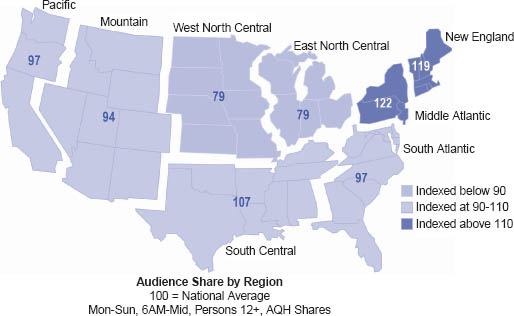
![]() Figure 2.1 Audience share by region – CHR (Source: Arbitron)
Figure 2.1 Audience share by region – CHR (Source: Arbitron)
When the marketer of recorded music and live performances uses geographic segmentation in this manner, it can help develop the logic for the use of resources to support the marketing plan. Marketing strategies are then easily tailored to particular geographic segments. For example, tour support relies on geographics to determine which cities to include in the promotion.
As the label’s act tours from city to city, the marketing department geographically shifts the focus of their efforts ahead of the actual performance date in each market.
Personal demographics are basic measurable characteristics of individual consumers and groups such as age, gender, ethnic background, education, income, occupation and marital status. Demographics are the most popular method for segmenting markets because groups of people with similar demographics have similar needs and interests that are distinct from other demographic segments. Also, demographics are easier and cheaper to measure than more complex segmentation variables such as personality and consumer behavior.
Age is probably the demographic most associated with changing needs and interests. Consumers can be divided into several age categories such as children, teens, young adults, adults and older adults. Recently, the segment of “tweens” has been added to the mix to account for the enormous spending power of this group of 23 million preadolescents between the ages of 8 and 13. This concept of segmenting based on age has even been extended to dog food, with companies positioning their various products to appeal to different stages of canine life.
Gender is also a popular variable for segmentation, as the preferences and needs of males are perceived as differing from those of females. Differential needs based upon gender are obvious for product categories such as clothing, cosmetics, hairdressing and even magazines. But even in the area of music preferences, differences in taste exist for males and females. Arbitron reports that males are more likely to listen to alternative, rock or news/talk radio, while women prefer top 40, country, adult contemporary and urban radio (Arbitron Radio Today: How America Listens to Radio, 2004).
Income segmentation is popular among certain product categories such as automobiles, clothing, cosmetics and travel but is not as useful in the recording industry. Educational level is sometimes used to segment markets. Well-educated consumers are likely to spend more time shopping, read more, and are more willing to experiment with new brands and products (Kotler, P., 1980). Segmentation by race is also important as certain product classes are targeted toward one race over another, including specific genres of music.
The process of combining two or more demographic or other variables to further segment the market has proven effective in accurately targeting consumers. By combining age, gender and income, marketers can better tailor the marketing messages to reach each group. For example, older males may prefer news/talk radio, whereas younger males prefer modern rock radio.
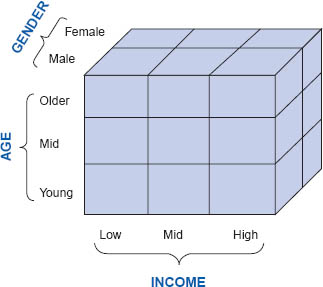
![]() Figure 2.2 Multivariable segmentation
Figure 2.2 Multivariable segmentation
Psychographic segmentation involves dividing consumers into groups based upon lifestyles, personality, opinions, motives or interests. Psychographic segmentation is designed to provide additional information about what goes on in minds. While demographics may paint a picture of what consumers are like, psychographics adds vivid detail, enabling marketers to shape very specific marketing messages to appeal to the target market.
By understanding the motive for making purchases, marketers can emphasize the product attributes that attract buyers. For example, if consumers are driven by price, pricing factors such as coupons can be emphasized. If another segment is driven by convenience, this issue can be addressed through widespread product distribution. Lifestyle segmentation divides consumers into groups according to the way they spend their time and the relative importance of things in their life.
Psychographics are more difficult to measure and are a moving target. Marketers are constantly updating information to stay abreast of changes in the marketplace. One such system is the VALS2 (values and lifestyles) segmentation system, developed by the Stanford Research Institute. VALS TM is a marketing and consulting tool that identifies current and future marketing opportunities by segmenting the consumer markets on the basis of the personality traits that drive consumer behavior. The system places consumers into three self-orientation categories of people primarily inspired either by ideals, achievement or self-expression. The market is further subdivided into eight segments by adding the variables of resources and innovation. Those consumers who possess abundant resources are placed in the upper categories. For example, thinkers are conservative and motivated by ideals; experiencers are young and enthusiastic and motivated by self-expression, excitement and innovation. More information is available at http://www.sric-bi.com/VALS/.
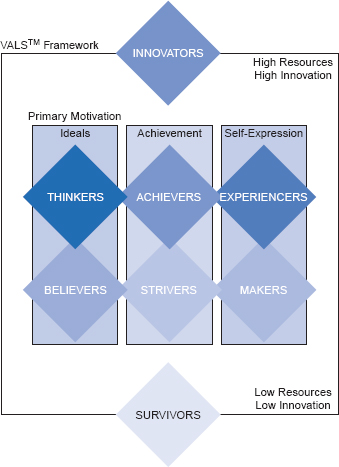
![]() Figure 2.3 Values and lifestyle segments (Source: SRI Consulting Business Intelligence)
Figure 2.3 Values and lifestyle segments (Source: SRI Consulting Business Intelligence)
Researchers at the University of Texas have found that personal music preferences can be linked to personality traits. Rentfrow & Gosling (Rentfrow, P.J. ʙ Gosling, S.D., 2003) found that people’s music preferences typically classify them into one of four basic dimensions: 1) reflective and complex, 2) intense and rebellious, 3) upbeat and conventional, or 4) energetic and rhythmic. Preference for each of the following music dimensions is differentially related to one of these basic personality traits.
Genres |
Personality |
Classical, jazz, blues, folk |
Reflective and complex |
Alternative, rock, heavy metal |
Intense and rebellious |
Country, pop, religious, soundtracks |
Upbeat and conventional |
Rap/hip-hop, soul/funk, electronica/dance |
Energetic and rhythmic |
The quest for cool
Marketers use a variety of research techniques to spot lifestyle trends as they develop, so that their products will be in the marketplace ahead of the demand and the competition. Known in vernacular terms as “cool hunting” or the “quest for cool,” these marketers are hired by well-known brands to track and understand youth culture. Then the principles of diffusion theory are applied to target opinion leaders in the hopes of penetrating the market (Grossman, L., August 31, 2003). Cool hunting involves observing alpha consumers (cool people) talking, eating, dressing or shopping and then predicting what the rest of the market will be doing a year from now. One such company, Look-LookTM, uses a variety of research techniques including surveys, field observations, ethnographies, mall intercepts and focus groups. They document their findings with photographs and video recordings and report their conclusions to a variety of major companies who are targeting the youth market (Look-Look, TM company website, 2004).
The millennial generation
Neil Howe and William Strauss discuss the emergence of a millennial generation, which they define as the generation of young adults, the first of whom have “come of age” around the time of the millennium (Howe, N. and Strauss, W., 2000). This segment includes people born between 1982 and 1995. The estimates range between 60 and 74 million, and they are expected to be a huge economic force. This segment is characterized by a sharp break from Generation X, and hold values that are at odds with the baby boomers. They are described as optimists—team players who follow the rules and accept authority. For this market segment, technology is a part of life, and staying connected to others is important (Bock, W., 2002).
Behavioral segmentation is based on actual customer behavior toward products. Behavioral segmentation has the advantage of using variables that are closely related to the product and its attributes. Some of the more common behavioral segmentation variables are: benefits sought, user rate, brand loyalty, user status, readiness to buy and purchase occasion.
Product usage
Product usage involves dividing the market based on those who use a product, potential users of the product, and nonusers—those who have no usage or need for the product. How a product is used (and for what purposes) is also of importance. For example, Kodak found that disposable cameras were being placed on tables for wedding guests to help themselves to. As a result, Kodak modified the product by offering five-pack sets of cameras in festive packaging (Nickels, W. G, and Wood, M., 1997). The recording industry has adapted to usage situations by repackaging music that is customized for usage occasion, such as wedding music compilations, party mixes, romantic mood music, and so forth.
Benefits sought
It is said that people do not buy products, they buy benefits. They buy aspirin to alleviate pain; toothpaste to whiten or protect teeth; and music to elevate mood, combat boredom, provide companionship, or create atmosphere. Benefit segmentation divides the market according to benefits sought by consumers. In the toothpaste market, some consumers are seeking a product that whitens teeth, while others may consider fresh breath most important. Still others may seek fluoride protection against cavities or protection against gum disease. To address these segments, toothpaste companies have all created product variations to accommodate each segment.
User status
User status defines the consumer’s relationship with the product and brand. It involves level of loyalty and propensity to become a repeat buyer. Stephan and Tannenholz identify six categories of consumers based on user status: sole users, semi-sole users, discount users, aware non-triers, trial/rejectors, and repertoire users.
User Status
Sole users are the most brand loyal and require the least amount of advertising and promotion.
Semi-sole users typically use brand A, but have an alternate selection if it is not available or if the alter nate is promoted with a discount.
Discount users are the semisole users of competing brand B. They don’t buy brand A at full price, but perceive it well enough to buy it at a discount.
Aware non-triers are category users, but haven’t bought into brand A’s message.
Trial/rejecters bought brand A’s advertising message, but didn’t like the product.
Repertoire users perceive two or more brands to have superior attributes and will buy at full price. These are the primary brand switchers; therefore, the primary target for brand advertising.
Stephan and Tannenholz
![]() Figure 2.4 User status (Source: Stephan and Tannenholz)
Figure 2.4 User status (Source: Stephan and Tannenholz)
Consumer behavior is defined as the buying habits and patterns of consumers in the acquisition and usage of goods and services. According to the American Marketing Association, consumer behavior is defined as “the dynamic interaction of affect and cognition, behavior, and environmental events by which human beings conduct the exchange aspects of their lives.” One consumer behavior construct is the hierarchy of effects model that combines involvement and left-right brain processing to determine the process a consumer goes through in making a purchase decision.
High and low-involvement decision making
Involvement refers to the amount of time and effort a consumer invests in the search, evaluation and decision process of consumer behavior (See AIDA models in chapter one). The level of involvement in the purchase depends on the risk of making the wrong decision and the product’s economic and social importance to the consumer. Consumers who search for information about products and brands in order to evaluate them thoroughly are engaging in high involvement decision making. They want to know as much as possible about all choices before making their decision.
In low involvement decision-making, the consumer perceives very little risk, low identification with the product and little or no personal relevance. Low involvement decision-making is often habitual, associated with consumer package goods (prone to repeat purchases) and characterized by brand familiarity and loyalty.
Several factors can influence a consumer’s level of involvement in a purchase process:
1. Previous experience – If consumers have previous experience with the product or brand, they are more likely to have a low level of involvement.
2. Interest – The more personal interest consumers have in the product, product class, or benefits associated with the product, the more likely they are to engage in high involvement behavior.
3. Perceived risk of negative consequences – If the stakes are high and the consequences of making the wrong decision are dire, consumers engage in high involvement behavior. Price is a variable associated with risk. High-priced purchases bear more risk. As price increases, so does the level of involvement.
4. Situation – Circumstance may play a role in temporarily raising the level of involvement. A food or beverage purchase casually made under most circumstances may call for more scrutiny if guests are coming to dinner. A CD bought for personal use is a rather low involvement purchase; when given as a gift it has higher involvement because of the risk of a bad decision.
5. Social visibility – Involvement increases as the social visibility of a product increases. Designer clothing falls into this situation.
Chapter 1 mentioned the stages involved in the consumer’s decision-making process. They were identified as awareness, information, decision and action (AIDA). This is part of the hierarchy of effects theory, which involves a series of steps by which consumers receive and use information in reaching decisions about what actions they will take (e.g., whether or not to buy a product).
A more elaborate model involves the following six steps:
1. Problem recognition – The consumer realizes that a purchase must be made. Perhaps a new need has emerged, or perhaps the consumer’s supply of a commonly used product has run low.
2. Information search – The consumer will seek out information about the various options available for satisfying the want, need, or desire.
3. Alternative evaluation – The consumer will look for alternate opinions of the product under consideration.
4. Purchase or acquisition – The consumer makes the purchase.
5. Use – The consumer uses the product, thereby gaining personal experience.
6. Post-purchase evaluation – Experience with the product leads to evaluation to determine if the product meets expectations and should be purchased again next time the need arises.
Cognitive vs. emotional decisions
Much research has been done in the field of advertising on the relative roles of affective factors vs. cognitive factors in motivating consumers. Cognition-based attitudes are thoughts and beliefs about an attitude object. Affect-based attitudes are emotional reactions to the attitude object. Attitudes can have both of these components, and can be based more or less on either cognitions or affect. While there is probably an element of both in each purchase decision, the relative contribution of each as well as the process involved, may differ depending upon the type of product and the level of involvement.
The model of the hierarchy of effects has been subsequently modified to include three constructs: cognition (awareness or learning), affect (feeling, interest or desire), and conation (action or behavior) – CAB. The order in which these steps are taken is subject to the type of product and the level of involvement. According to Richard Vaughn, product category and level of involvement may determine the order of effects as well as the strength of each effect (Vaughn, R., Feb/Mar, 1986). His model uses involvement (high/low) and think/feel (cognitive or affective components) as the two dimensions for classifying product categories and ordering these three steps.
To begin with, high-involvement situations suggest that the cognitive stage and the affective stage usually appear first, and these two stages are followed by the conation (behavioral) stage. In low-involvement situations, advertising may create awareness first, but attitudes or brand preferences are formed after product trial or experience. Thus, conation or action occurs before opinions are formed about the product. In other words, the thinking and/or feeling occur before the action in high-involvement situations, whereas opinions are formed only after trial of the product in low-involvement situations. Low involvement products are more subject to impulse purchases.
The resulting model is a four-quadrant grid with quadrant one (informative) containing high involvement cognitive products, quadrant two (affective) for high involvement emotional purchases, quadrant three (habitual) for low involvement rational purchases, and quadrant four (satisfaction) for low-involvement emotional purchases. Music purchases generally fall into the satisfaction quadrant, although as prices increase, so does the level of involvement. Some music purchases can be considered impulse buys, if correctly positioned at retail. Other purchases may require creating the emotional (affective) response in the customer. Since music by its very nature evokes emotional responses, exposure to the product is known to increase purchase rate.
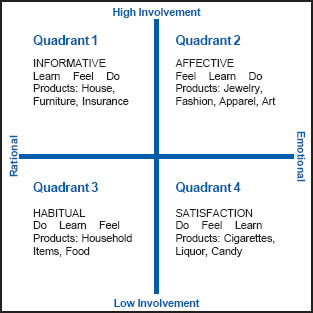
![]() Figure 2.5 Hierarchy of effects (Source: Foote, Cone and Belding)
Figure 2.5 Hierarchy of effects (Source: Foote, Cone and Belding)
When a product is purchased, it is usually to fill some sort of need or desire. There is some discrepancy between the consumer’s actual state and their desired state. In response to a need, consumers are motivated to make purchases. Motives are internal factors that activate and direct behavior toward some goal. In the case of shopping, the consumer is motivated to satisfy the want or need. Understanding motives is a critical step in creating effective marketing programs. Psychologist Abraham Maslow developed a systematic approach of looking at needs and motives.
Maslow states that there is a hierarchy of human needs. More advanced needs are not evident until basic needs are met first. Maslow arranges these needs into five categories of physiological, safety, love, esteem and self-actualization. Marketers believe that it is important to understand where in the hierarchy the consumer is before designing an effective marketing program.
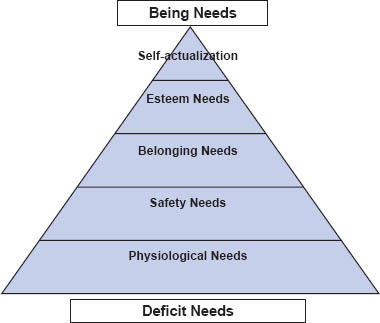
![]() Figure 2.6 Maslow’s hierarchy of needs (Source: Abraham Maslow)
Figure 2.6 Maslow’s hierarchy of needs (Source: Abraham Maslow)
Physiological needs are the basic survival needs that include air, food, water, sleep, and sex. Until these needs are met, there is little or no interest in fulfilling higher needs. Survivors in the VALs system fit into this category. Safety needs deal with establishing a sense of security. Safety needs motivate consumers to seek political and religious solutions. Until these needs are met, the need for love and belongingness are absent. Love, approval and belongingness are the next level along with feeling needed and a sense of camaraderie. Products oriented toward social events sometimes appeal to this need and this may include music. Esteem needs drive people to seek validation and status. Self-actualization involves seeking knowledge, self-fulfillment, and spiritual attainment.
One of the greatest challenges facing marketers is converting potential customers who are browsing the merchandise into actual purchasers. Retail stores refer to a conversion rate—the percentage of shoppers who actually make a purchase. The actual rate varies and depends upon the level of involvement, with small-ticket items having a higher conversion rate to expensive items such as appliances or jewelry. A mall store will have more walk-in traffic and thus a lower conversion rate than a freestanding “destination” store. Conversion rates can be improved by having the right combination of merchandise, presenting the merchandise correctly and offering a level of service that meets or exceeds expectations. When shoppers don’t buy, it’s often because they were unable to find what they wanted.
Online, conversion rates are improved by offering purchase opportunities with a minimum amount of consumer effort. This is why many online stores such as Amazon.com offer accounts to customers with their address and credit card information stored in the system. The consumer can purchase with one mouse click.
ADI – Area of Dominant Influence (see DMA).
Affect – A fairly general term for feelings, emotions, or moods.
Behavioral segmentation – Based on actual customer behavior toward products.
Cognition – All the mental activities associated with thinking, knowing, and remembering.
Conation – represents intention, behavior, and action.
Consumer behavior – The dynamic interaction of affect and cognition, behavior, and environmental events by which human beings conduct the exchange aspects of their lives.
DMA – Designated Marketing Area. The geographic area surrounding a city in which the broadcasting stations based in that city account for a greater share of the listening or viewing households than do broadcasting stations based in other nearby cities.
Geographic segmentation – Dividing the market into different geographical units such as town, cities, states, regions and countries. Markets also may be segmented depending upon population density, such as urban, suburban or rural.
Involvement – The amount of time and effort a consumer invests in the search, evaluation and decision process of consumer behavior.
Market – A set of all actual and potential buyers of a product. The market includes anyone who has an interest in the product and has the ability and willingness to buy.
Market segmentation – The process of dividing a large market into smaller segments of consumers that are similar in characteristics, behavior, wants or needs. The resulting segments are homogenous with respect to characteristics that are most vital to the marketing efforts.
Personal demographics – Basic measurable characteristics of individual consumers and groups such as age, gender, ethnic background, education, income, occupation and marital status.
Psychographic segmentation – Dividing consumers into groups based upon lifestyles, personality, opinions, motives or interests.
Target market – A set of buyers who share common needs or characteristics that the company decides to serve.
User status – The consumer’s relationship with the product and brand. It involves level of loyalty.
Arbitron Radio Today: How America Listens to Radio (2004). http://www.arbitron.com/downloads/radiotoday04.pdf.
Bock, W. (2002). http://www.mondaymemo.net/010702feature.htm.
Evans, J. R. and Berman, B. (1992). Marketing (fifth edition), New York: Macmillan Publishing.
Finch, J. E. (1996). The Essentials of Marketing Principles, Piscataway: Research and Education Association.
Grossman, L. (August 31, 2003). The Quest for Cool, Time Magazine.
Hall, C. and Taylor, F. (2000). Marketing in the Music Industry (4th edition), Boston: Pearson Custom Publishing.
Howe, N. and Strauss, W. (2000). Millennials Rising: The Next Great Generation, New York: Vintage Books.
Kotler, P. (1980). Principles of Marketing, Englewood Cliffs: Prentice-Hall.
Look-Look company website (2004). http://www.look-look.com/dynamic/looklook/jsp/What_We_Do.jsp.
Marketing Teacher (2004). http://www.marketingteacher.com/Lessons/lesson_positioning.htm.
Nickels, W. G, and Wood, M. (1997). Marketing, New York: Worth Publishers.
Rentfrow, P. J. and Gosling, S. D. (2003). The Do-Re-Mi’s of Everyday life: Examining the structure and personality correlates of music preferences, Journal of Personality and Social Psychology, 84, pp. 1236–1256.
The American Marketing Association (2004). www.marketingpower.com.
Vaughn, R. (Feb/Mar, 1986). How Advertising Works, Journal of Advertising Research.
______________________
i Stephan and Tannenholz in Arens, William F. (2002). Market Segmentation and the Marketing Mix: Determinants of Advertising Strategy. McGraw-Hill Online Learning Center. http://highered.mcgraw-hill.com/sites/0072415444/student_view0/chapter5/els.html
